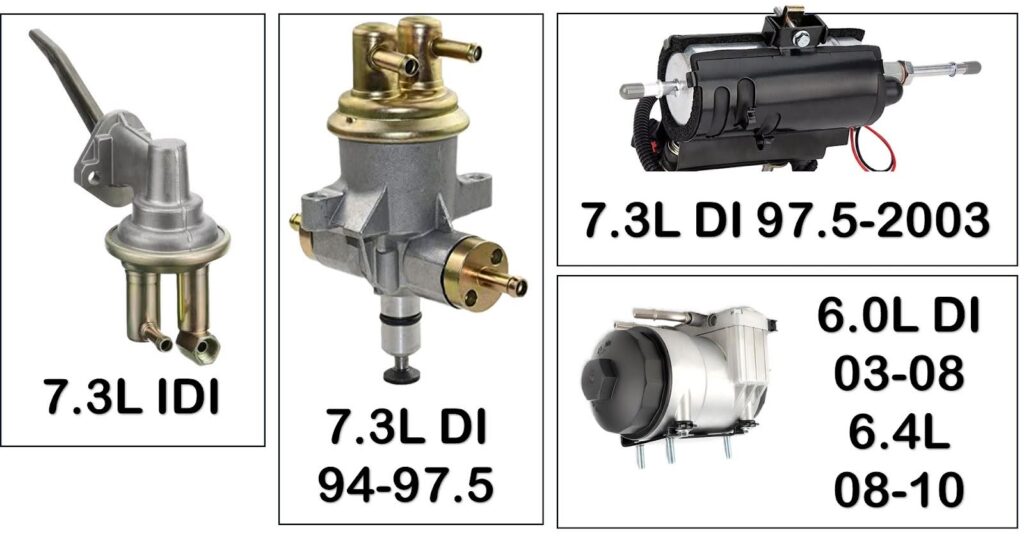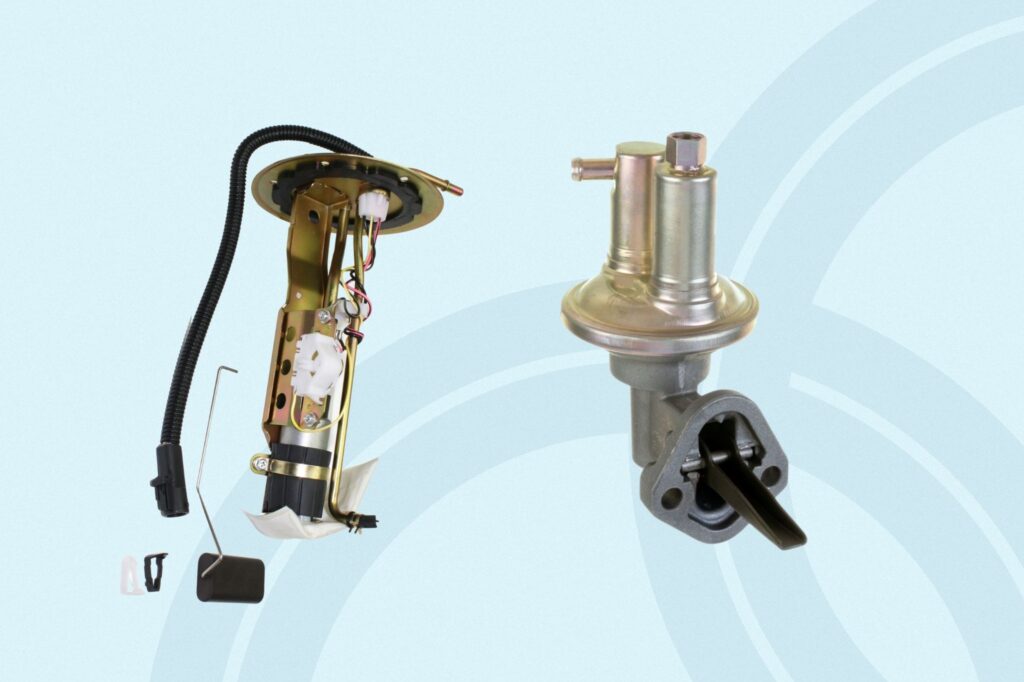Diesel-powered Ford vehicles are definitely some of the best workhorses out there. However, as reliable as they are, they can still develop some issues after some time, reducing their efficiency.
Some owners over the years have described a faulty fuel pump in certain Ford diesels. If you encounter it, this article can help you understand why the pump failed and the best practices when it comes to maintenance.
A Rundown On Fuel Pump Operation
Before electronic diesels, the fuel injector pump drew the fuel out of the tank like carbureted fuel pumps with a lever-driven pump mounted on the side of the engine.
With the advent of the first generation 7.3L Powerstroke diesel in 1994, a mechanical camshaft driven stroker pump is mounted in the valley between the heads, feeds it through the filter on the engine to the injectors at 55-80 psi, and the injectors are operated by high oil pressure from another camshaft mounted pump.

Beginning in mid-model year 1997, the 7.3L Powerstroke has an electric fuel pump mounted on the frame that feeds the injectors with 50 psi of fuel pressure, but the injectors are still “popped” by carefully controlled high oil pressure from the gear-driven oil pump.
The 6.0L Powerstroke has its electric fuel pump mounted in the “Horizontal Fuel Conditioning Module,” and the fuel is delivered to the injectors, which are oil pressure-driven.
The 6.4L Powerstroke is a common rail system, which uses a high pressure fuel pump to charge the fuel rails, but the Horizontal Fuel Conditioning Module still feeds the high pressure fuel pump.
Electric vs. Mechanical Fuel Pump

Fuel pumps can either be electric or mechanical.
Electric Fuel Pump
An electric fuel pump relies on an electric motor for fuel delivery. The powertrain control module controls the operation of the fuel pump, which starts as soon as the engine is on.
Once the fuel pump is running, it’ll create a vacuum in the fuel line to draw fuel and push it towards the engine.
Mechanical Fuel Pump
A mechanical fuel pump relies on a piston instead of a motor to push fuel from the tank to the engine.
Most mechanical fuel pumps are camshaft-driven. Similar to an electric fuel pump, a mechanical fuel pump starts as soon as the engine starts spinning, but electric fuel pumps will run for a few seconds when the key is turned on even if the engine isn’t spinning.
Understanding Diesel Fuel Pumps
Diesel and gasoline fuel pumps share similar objectives, but they usually differ in terms of design and capacity.
Diesel fuel supply pumps provide fuel either to the injectors on older Powerstrokes or to the high pressure fuel pump on common rail systems like the 6.4L and 6.7L Powerstrokes. The pressure in the oil rail is controlled electronically on older Powerstrokes, but the fuel pressure is controlled in the Common Rail on the newer ones.
The older Powerstrokes had a high pressure oil pump to drive the intensifier piston in each injector. The oil feed to the intensifier piston is electrically controlled by high voltage (115 volts on 7.3L and about 50 volts on 6.0L). Newer Powerstrokes have high pressure delivered to the injector, which is triggered electrically to open.
How to Spot a Failing Ford Diesel Fuel Pump
A failing fuel pump will most likely cause your Ford vehicle to exhibit the following symptoms: power loss, difficulty in starting the engine, misfires, and an illuminated check engine light.
Power Loss
An engine that’s losing power upon acceleration can point to an inconsistent fuel supply due to a faulty fuel pump. This symptom can also be accompanied by a reduction in fuel efficiency.
Hard-Starting Engine
Issues with the fuel pump can lead to inadequate fuel supply reaching the injectors. This will make it difficult for the engine to turn, especially under cold temperatures.
Engine Misfires
Poor fuel delivery can lead to an incomplete combustion process, which is also known as an engine misfire.
Illuminated Check Engine Light
An illuminated check engine light can mean many things, including a damaged fuel pump.
Causes of Fuel Pump Failure
The fuel pump can fail due to several reasons, such as fuel contamination, overheating, and regular wear and tear.
Contaminated Fuel
Water, debris, and metal particles can easily damage the fuel pump and affect its operation. These contaminants can be mixed with diesel fuel and lead to drivability issues.
Overheated Pump
Many drivers like to ride out their fuel tanks to the point where the low fuel light pops up on their dash. If done frequently, this practice can cause the fuel pump to overheat due to poor lubrication.
Metal-To-Metal Contact
The fuel pump isn’t spared from regular wear and tear. Over time, the fuel pump might come into contact with other metal parts, affecting its service life.
Preventive Measures to Keep Your Fuel Pump Operational
Your fuel pump isn’t meant to last forever, but that doesn’t mean you can’t prolong its service life.
If you want to make the most out of your fuel pump, always make sure you have enough fuel in the tank to keep it lubricated. Remember that a vehicle that’s running low on fuel will only cause the pump to work harder, leading to accelerated wear.
And, as always, sticking to your vehicle’s preventive maintenance schedule is always key to avoiding car trouble. Make sure to replace your fuel filter every 15,000 miles or depending on your vehicle’s specifications to ensure that the fuel that goes in the pump is free from contaminants.
Fuel Pump Replacement FAQs
What is the life expectancy of a diesel fuel pump?
A diesel fuel pump should last 100,000 miles or more. The estimated lifespan of a fuel pump greatly varies and can be affected by irregular maintenance and poor driving habits.
How much will a fuel pump replacement cost?
A fuel pump replacement can cost anywhere between $500 and $600 on parts alone. You can expect to throw in $600 to $700 for labor fees.
How do you test a diesel fuel pump?
Testing a diesel fuel pump generally involves fuel pressure monitoring. You might need diagnostic tools like a low-pressure gauge to monitor pressure changes.
You might also need to perform a dynamic test where you leave the engine idling.
How to Get a High-Grade Replacement Ford Fuel Pump
Careful driving and regular maintenance can prolong the Ford fuel pump’s service life. However, the part can still fail ahead of the manufacturer’s expectations, requiring prompt replacement before it causes problems. Luckily, finding a quality Ford fuel pump is easy at CarParts.com.
CarParts.com offers a simple, straightforward online shopping experience for a replacement Ford fuel pump. Simply enter the year, model, and engine of your Ford in our website’s integrated vehicle selector.
We carry a wide selection of diesel and gasoline fuel pumps for many Ford models. Each product is exclusively sourced from trusted manufacturers and vetted by our team of experts to ensure it meets world-class standards. Our nearest distribution center will ship your new Ford fuel pump to your address within several business days if you live in the continental US and order before noon ET.
Get your Ford up and running again with a competitively priced fuel pump from CarParts.com. Order a Ford fuel pump today and enjoy big savings on your purchase!
Any information provided on this Website is for informational purposes only and is not intended to replace consultation with a professional mechanic. The accuracy and timeliness of the information may change from the time of publication.





















